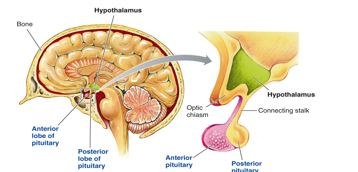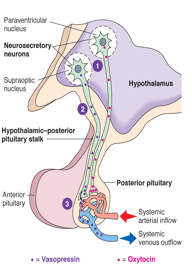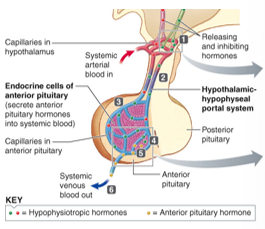hypothalamic pituitary axis and feedback control
1/16
There's no tags or description
Looks like no tags are added yet.
Name | Mastery | Learn | Test | Matching | Spaced |
|---|
No study sessions yet.
17 Terms
hypothalamus and pituitary gland
hypothalamus: key regulator of the endocrine system. It integrates signals from the brain and the body, using this information to control hormonal secretions. regulates the function of thyroid, adrenal gland, reproductive glands
pituitary gland (master gland): releases hormones that regulate many bodily functions. responsible for somatic growth lactation, milk secretion

hypothalamus
represents less than 1% of the brain mass
connected with many areas of the brain and spinal cord
acts as an interface between internal and external environment
external responses - emotional, instinctual, appetite
internal homeostatic responses are produced through ANS and endocrine system - endocrine link in through the hypothalamic pituitary axis
pituitary gland (hypophysis)
small gland
physiologically divisible in two distinct portions: anterior pituitary (adenohypophysis) and posterior pituitary (neurohypophysis)
embryologically these two portions originate from different sources
hypothalamus and pituitary relationship
release of hormones from the pituitary gland is regulated by the hypothalamus by 2 different types of signals
posterior pituitary (neural pathway): direct neural signals stimulate the release of hormone. instant messages to release stored hormones
anterior pituitary (vascular link): specialized blood vessel system, the hypophyseal portal system, transports hormonal signals from the hypothalamus

hypothalamus and posterior pituitary
certain nerve cells in the hypothalamus (called neurosecretory neurons) make hormones that are released into the blood to affect organs far away
supraoptic nucleus (SON)
produces mostly vasopressin (ADH)
contributes to oxytocin production but to a lesser extent
paraventricular nucleus (PVN)
er focus on oxytocin produces a mix of oxytocin and vasopressin with a slightly high
also releases corticotropin releasing hormone (CRH) for stress responses
pituitary hormone synthesis and secretion
hormones (vasopressin/ADH and oxytocin) are first made in their inactive form (pro-hormones)
transport to posterior pituitary
hormones are carried down nerve fibres to the posterior pituitary with the help of special proteins called neurophysins
this takes several days
release into blood
when nerve signals arrive, the hormone are released from the nerve endings into the nearby blood vessels
both the hormone and the carrier protein are released but they separate quickly, and the hormone enters the bloodstream
oxytocin function
helps release milk from the breast during breastfeeding
makes muscles in the mammary gland squeeze milk into ducts
milk is then removed by the infant while suckling
triggers uterine contractions, which help during childbirth
sometimes used medically to start or aid labour
its role in men is not clearly understood
role of vasopressin/ antidiuretic hormone (ADH)
water retention
ADH helps the kidneys save water by making certain parts more absorbent.
this concentrates urine, reduces water loss, and keeps the body hydrated, especially during dehydration
blood vessel constriction
ADH can tighten blood vessels, which helps increase blood pressure
this is especially important during blood loss or low blood pressure (hypotension)
control of ADH secretion
dehydration
less water in the body makes blood more concentrated (higher osmolality)
special cells in the brain sense this change and signal for more ADH to be released
ADH helps the kidneys save water, reducing urine and fixing the imbalance
after drinking
extra water dilutes the blood (lower osmolality)
osmoreceptors stop signaling and less ADG is released
the kidneys remove the extra water by producing more urine
factors affecting ADH release
stimulators of ADH release
low blood volume or pressure (after bleeding)
dehydration or increased blood concentration (higher osmolality)
physical stress (pain) and emotional stress
aging: older individuals often secrete more ADH than younger ones
inhibitors of ADH release
high blood volume or pressure
drinking alcohol
how ADH responds
at normal levels, ADH responds balance water in the body
mild dehydration: ADH secretion can increase 3-5times
severe cases: ADH release can surge up to 50 times to help conserve water and maintain blood pressure
hormone secretion by anterior pituitary
anterior pituitary releases hormone through a process starting with special hormones in the hypothalamus (releasing and inhibiting hormones)
these hormones travel through small blood vessels (hypothalamic-hypophyseal portal system) to the anterior pituitary
once there, they tell the anterior pituitary cells to either release or stop releasing specific hormones
hypothalamic hypophyseal portal system
specialized blood vessel network that directly links the hypothalamus and anterior pituitary
hormones from the hypothalamus: special hormones (releasing and inhibiting) are collected by capillaries in the hypothalamus
travel to the anterior pituitary: these capillaries merge into portal vessels, which carry hormones down the pituitary stalk
action on pituitary cells the portal vessels branch into a second network of capillaries in the anterior pituitary, delivering the hormones directly to pituitary cells
release to the body: after acting on the pituitary, the blood flows into the rest of the body

hypothalamus and anterior pituitary gland
anterior pituitary gland contains several different cell types that synthesize and secrete these hormones (peptide hormones)
gonadotropes: produce FSH (follicles stimulating hormone) and LH (luteinizing hormone) which control reproduction
corticotropes: produce (ACTH) (adrenocorticotropic hormone) which helps the body respond to stress
thyrotropes: produce TSH ( thyroid stimulating hormone) which regulates the thyroid gland
lactotropes: produce prolactin )PRL) which is important for milk production
somatotropes: produce growth hormone (GH) essential for growth and metabolism
FLAT PiG
each pituitary hormone is controlled by at least one hypothalamic hormone
hypothalamic hypophysiotropic hormones
thyroidotropin-releasing hormone (TRH) - stimulates release of TSH (thyrotropin) and PRL. targets the thyroid glands for thyroid hormone production
corticotropin-releasing hormone (CRH) - stimulates release of ACTH (corticotropin). targets adrenal glands for glucocorticoid production
gonadotropin-releasing hormone (GnRH) - stimulates release of FSH and LH (gonadotropins). targets reproductive system for sex hormone/gamete production
growth hormone-releasing hormone - stimulates release GH (growth hormone). targets liver, bone, muscles for IGF production
growth hormone-inhibiting hormone (GHIH/somatostatin) - inhibits release of GH and TSH. targets liver, bone, muscles for IGF production
prolactin-inhibiting hormone (PIH/dopamine) - inhibits release of PRL. targets mammary glands for milk production
prolactin-releasing hormone (PRH) - stimulates release of PRL. targets mammary glands for milk production
feedback types
long loop feedback: hormones from target glands (e.g. thyroid hormones) travel back to the hypothalamus or pituitary to reduce their own stimulation
short loop feedback: hormones from the pituitary act on the hypothalamus to adjust its releasing hormone
ultra short loop feedback: hypothalamus controls its own hormone release through very quick feedback mechanisms
feedback control in stress response
stress starts process: hypothalamus releases corticotropin releasing hormone (CRH)
pituitary response: CRH signals the anterior pituitary to release adrenocorticotropic hormone (ACTH)
adrenal gland action: ACTH stimulates the adrenal glands to produce cortisol
feedback regulation: high cortisol levels send a signal back to the hypothalamus and pituitary to reduce CRH and ACTH production, balancing the system
thyroid feedback system
initiation: hypothalamus releases thyrotrophin-releasing hormone (TRH) which signals to the anterior pituitary to release TSH
action: TSH (thyroid stimulating hormone) tells the thyroid gland to produce thyroid hormones (T3 and T4)
feedback: when T3 and T4 levels are high, they signal the hypothalamus and pituitary to reduce TRH and TSH production, creating a negative feedback loop